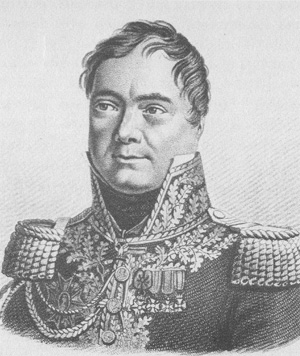General Georges Mouton

Born: February 21, 1770
Place of Birth: Phalsbourg, Moselle, France
Died: November 27, 1838
Cause of Death: Wounds never fully healed
Place of Death: Paris, France
Arc de Triomphe: MOUTON on the east pillar
Pronunciation:
The son of a baker, Georges Mouton first volunteered in August of 1792 for the 9th Battalion of Volunteers of Meurthe and he was then elected a lieutenant. Serving with the Army of the Center, he was promoted to capitaine in November and he also served in the Electorate of Trier. The next year Mouton joined the Army of the Moselle and then later the Army of the Rhine where he became an aide-de-camp to Meynier. In 1795 Mouton joined the Army of Italy where he would serve for the next six years. During the Italian campaign of 1796, he participated in the Siege of Mantua . In 1797 he was promoted by General Bonaparte to chef de bataillon and he later became an aide-de-camp to General Joubert. The next year Championnet placed him in charge of the fort of Saint-Ange, and then in 1799 he was promoted to chef de brigade of the 3rd of the Line and he fought at Novi under Laboissière. In December Mouton fought at Monte Faccio near Genoa and he received a wound to the left shoulder. During the defense of Genoa he served in Gazan's division and then he covered the retreat and won glory in the fighting around the mountain of Hermette. At the attack on Fort Quezzi he was badly wounded by a ball to the right arm.
During the years of the Consulate Mouton was appointed colonel of the 3rd of the Line and then in 1805 he was promoted to général de brigade and named an aide-de-camp to Napoleon. As an aide-de-camp, he assisted Napoleon by advising him on officers and promotions.1 He also served notably in battle on the campaigns of 1805 to 1807, serving at Austerlitz, Jena, Eylau, and at Friedland where he was grievously wounded. For his service he was made a Commander of the Iron Crown and a Commander of the Order of Military Merit of Wurtemberg and promoted to général de division.
Taking part in the invasion of Spain, General Mouton commanded the 2nd Infantry Division under Bessières and distinguished himself at Medina del Rio Seco . Taking command of a different division in II Corps, he fought at Burgos and then quit his command a few weeks later to serve as an aide-de-camp to Napoleon again. When Napoleon returned to France, Mouton followed and he took part in the Danube campaign of 1809 against Austria. After fighting at Abensberg, at Landshut Mouton led the storming of the blazing bridge, causing Napoleon to make the pun, "My sheep is a lion!"2 (The French word 'mouton' translates to sheep). Continuing to serve as an aide-de-camp, Mouton fought at Eckmühl and then at Aspern-Essling where he was placed in charge of the Fusiliers of the Guard and ordered to counterattack against the Austrians assaulting Essling. Another aide-de-camp of Napoleon's, General Rapp, was ordered to reinforce the village of Aspern, but upon seeing the size of the force against Mouton, he disobeyed orders and rode to Mouton's aid. Their combined forces successfully forced back the Austrian attack and enabled the French to retain possession of the village. During the retreat of the French to the isle of Lobau, Mouton was wounded by a ball, but rewarded for his bravery by Napoleon making him a count. After serving at Wagram , in the next few years Napoleon gave Mouton the title of Count of Lobau and Mouton became a Knight of the Order of Saint Hubert of Bavaria.
In 1812 Mouton continued in his aide-de-camp duties and he took part in the Russian campaign. When Napoleon left the army during the retreat and returned to Paris, Mouton accompanied him. The next year Mouton was rewarded with a Grand Cross of the Order of the Reunion and then in May he fought at Lützen by leading Ricard's division in the attack on the village of Kaya. That September he took command of I Corps at Dresden and he fought at Giesshubel before fighting at Racknitz the next month. When the French finally surrendered Dresden in November, Mouton became a prisoner of war and he was sent to Hungary.
Finally returning to France in June of 1814, before long Mouton was put on non-activity. After Napoleon's return from Elba in 1815 Mouton again became an aide-de-camp. Mouton was also made a Peer of France and then given command of VI Corps. After fighting at Ligny, he took part in the Battle of Waterloo before being captured at Plancenoit in the evening. Sent to England as a prisoner of war, the new French government proscribed him but could not touch him in England. Once released, he moved to Belgium until he was finally allowed to return to France at the end of 1818. In 1828 he entered politics as a deputy of Meurthe in the arrondissement of Lunéville. He supported Louis Philippe in 1830 and was later made a Marshal of France in 1831.
Notes
- John R. Elting, Swords Around a Throne: Napoleon's Grande Armée, (USA: Da Capo Press, 1997), 688.
- Philip J. Haythornthwaite, Who Was Who in the Napoleonic Wars, (London: Arms & Armour, 1998), 226.
Bibliography
- Chandler, David G. Dictionary of the Napoleonic Wars. New York: Macmillan Publishing, 1979.
- Haythornthwaite, Philip J. Who Was Who in the Napoleonic Wars. London: Arms & Armour, 1998.
- Six, Georges. Dictionnaire Biographique des Généraux & Amiraux Français de la Révolution et de l'Empire (1792-1814). 2 vols. Paris: Gaston Saffroy, 2003.
Related Pages:
External Links:
Updated April 2023
© Nathan D. Jensen